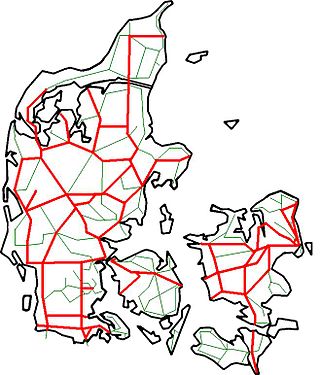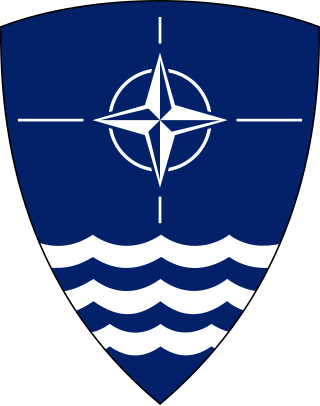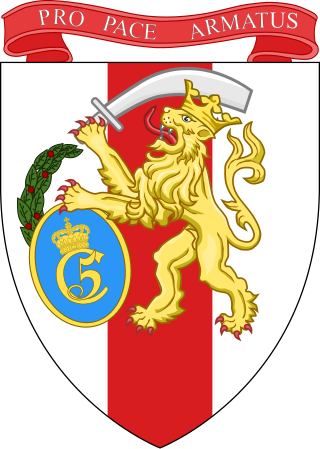
The Prince's Life Regiment was a Royal Danish Army infantry regiment. The motto of the regiment was "Gloria Finis".

The Jutland Dragoon Regiment is the only regiment of the Royal Danish Army that has an armored (MBT) battalion, and is one of the Danish combat regiments in which soldiers are entitled to wear the black beret of the Armoured corps.

The history of rail transport in Denmark began in 1847 with the opening of a railway line between Copenhagen and Roskilde. The Kiel-Altona line in Holstein was completed three years earlier, but the region was later lost to the German Confederation in the Second War of Schleswig.

The Zealand Life Regiment was a Royal Danish Army infantry regiment. On 1 January 2001 it was disbanded and amalgamated into the Guard Hussar Regiment, which was moved from Næstved to Slagelse.

The Danish Life Regiment was an infantry regiment of the Royal Danish Army. On 1 January 2001 it was merged with Sjællandske Livregiment, into Gardehusarregimentet.

The Funen Life Regiment was an infantry regiment of the Royal Danish Army. On 1 November 1991 it was merged with the King's Jutlandic Regiment of Foot, into Slesvigske Fodregiment.

The Danish Artillery Regiment is an artillery unit of the Royal Danish Army, which was founded on 1 November 2005 when the two artillery regiments in Denmark, King's Artillery Regiment and Queen's Artillery Regiment were merged. The unit was disbanded in 2014 and revived in 2019.

The Schleswig Regiment of Foot is a Royal Danish Army infantry regiment. On 1 January 2001, the regiment was merged with the Queen's Life Regiment to form the Prince's Life Regiment. In 2018, it was announced that the regiment would be reestablished on 1 January 2019 as a light infantry battalion.

The Falster Foot Regiment was a Royal Danish Army infantry regiment. On 1 August 1976 it was amalgamated into the Danish Life Regiment, where four out of five battalions continued to exist until 1981.

Jutland, known anciently as the Cimbric or Cimbrian Peninsula, is a peninsula of Northern Europe that forms the continental portion of Denmark and part of northern Germany. The names are derived from the Jutes and the Cimbri, respectively.

Allied Forces Baltic Approaches (BALTAP) was a Principal Subordinate Command (PSC) of the NATO Military Command Structure, with responsibility for the Baltic Sea area. It was in existence from 1962 to 2002 and consisted of the Danish Armed Forces, units of the West German Bundeswehr and allied wartime reinforcements.

The Marine Regiment was the naval infantry of the Royal Dano-Norwegian Navy, and later an infantry regiment, established in 1672 by Christian IV and based at Glückstadt Naval Station.
The following is a hierarchical outline for the Danish armed forces at the end of the Cold War. It is intended to convey the connections and relationships between units and formations. In wartime all Danish military units would have come under the joint West German/Danish NATO command Allied Forces Baltic Approaches (BALTAP). BALTAP was a principal subordinate command under the Allied Forces Northern Europe Command (AFNORTH). The commander-in-chief of (BALTAP) was always a Danish Lieutenant General or Vice Admiral, who had the designation Commander Allied Forces Baltic Approaches (COMBALTAP). In peacetime BALTAP had only a few communication units allocated and all other units remained under national command of West Germany's Bundeswehr and Denmark's Forsvaret.

The Jutlandic Regiment of Foot was a Royal Danish Army infantry regiment. On 1 November 1961, it was amalgamated with the King's Regiment of Foot, to create the King's Jutlandic Regiment of Foot.

The King's Regiment of Foot was a Royal Danish Army infantry regiment. On 1 November 1961, it was amalgamated with the Jutlandic Regiment of Foot, to create the King's Jutlandic Regiment of Foot.

The Queen's Life Regiment was a Royal Danish Army infantry regiment. On 1 January 2001, it was amalgamated with the Prince's Life Regiment.

The King's Jutlandic Regiment of Foot was a Royal Danish Army infantry regiment. On 1 November 1991, it was merged with the Funen Life Regiment, into Schleswig Regiment of Foot.
This article lists the structure of the Royal Danish Army in 1989 and in May 2020:

The Western Regional Command was the overall command of all Royal Danish Army units in Jutland and on Funen. It was split into four military regions, and was responsible for the regional defence. In 1990, the Regional Commands were disbanded and control was collected at the newly created Army Operational Command.


















